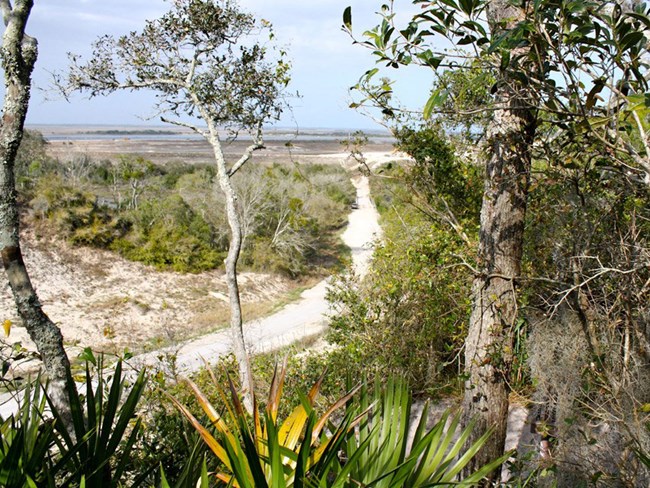Last updated: June 17, 2024
Article
NPS Geodiversity Atlas—Fort Caroline National Memorial, Florida
Geodiversity refers to the full variety of natural geologic (rocks, minerals, sediments, fossils, landforms, and physical processes) and soil resources and processes that occur in the park. A product of the Geologic Resources Inventory, the NPS Geodiversity Atlas delivers information in support of education, Geoconservation, and integrated management of living (biotic) and non-living (abiotic) components of the ecosystem.

Introduction
Fort Caroline National Memorial (FOCA) is jointly administered with TIMU and is located on the St. Johns River approximately 10 km (6 mi) upstream from the Atlantic Ocean in Duval County, Florida. Authorized on September 21, 1950, FOCA encompasses about 55 hectares (138 acres) and memorializes the French colonists who came to North America during the 16th century seeking religious freedom, wealth, and territorial expansion (National Park Service 2012c). Founded in 1564, the French colony of Fort de la Caroline represents one of the earliest European colonies in the New World, but proved to be a short-lived settlement that marked the beginning of two centuries of French and Spanish colonial rivalry in North America.
Geologic Setting
Timucuan Ecological and Historic Preserve and Fort Caroline National Memorial, along with the entire state of Florida, lies on the Floridian Plateau, a physiographic section approximately 800 km (500 mi) long and 400 – 640 km (250 – 400 mi) wide. The plateau, which has existed for millions of years, includes both emergent land and submerged continental shelf. Areas on the plateau have been alternately covered by seawater and exposed as dry land many times in the past so that marine and terrestrial deposits have been deposited one on top of the other.
The surface geology of Timucuan and Fort Caroline includes:
- Pleistocene (1.8 million years to 10,000 years ago) to Holocene (10,000 years ago to present) beach ridge and dune deposits
- Pleistocene - Holocene undifferentiated deposits, and
- Holocene sediments deposited in salt marsh, beach, marine, and lagoon environments.
Sedimentary rocks and undifferentiated sediments in the subsurface, to a depth of about 30 m (100 ft), include:
- Quaternary sands, clay-rich and limestone layers from the Upper Miocene (11.6 – 5.3 million years ago) or Pliocene (5.3 – 1.8 million years ago), and
- mixed deposits from the Upper Oligocene (28.4 – 23.0 million years ago) to Miocene Hawthorn Group.
Regional Geology
Fort Caroline National Monument is a part of the Floridian Plateau section of the Coastal Plain Physiographic Province and shares its geologic history and some characteristic geologic formations with a region that extends well beyond park boundaries.
- Scoping summaries are records of scoping meetings where NPS staff and local geologists determined the park’s geologic mapping plan and what content should be included in the report.
- Digital geologic maps include files for viewing in GIS software, a guide to using the data, and a document with ancillary map information. Newer products also include data viewable in Google Earth and online map services.
- Reports use the maps to discuss the park’s setting and significance, notable geologic features and processes, geologic resource management issues, and geologic history.
- Posters are a static view of the GIS data in PDF format. Newer posters include aerial imagery or shaded relief and other park information. They are also included with the reports.
- Projects list basic information about the program and all products available for a park.
Source: NPS DataStore Saved Search 2853. To search for additional information, visit the NPS DataStore.
A NPS Soil Resources Inventory project has been completed for Fort Caroline National Memorial and can be found on the NPS Data Store.
Source: NPS DataStore Saved Search 2921. To search for additional information, visit the NPS DataStore.
Related Articles
Fort Caroline National Memorial
National Park Service Geodiversity Atlas
The servicewide Geodiversity Atlas provides information on geoheritage and geodiversity resources and values within the National Park System. This information supports science-based geoconservation and interpretation in the NPS, as well as STEM education in schools, museums, and field camps. The NPS Geologic Resources Division and many parks work with National and International geoconservation communities to ensure that NPS abiotic resources are managed using the highest standards and best practices available.

